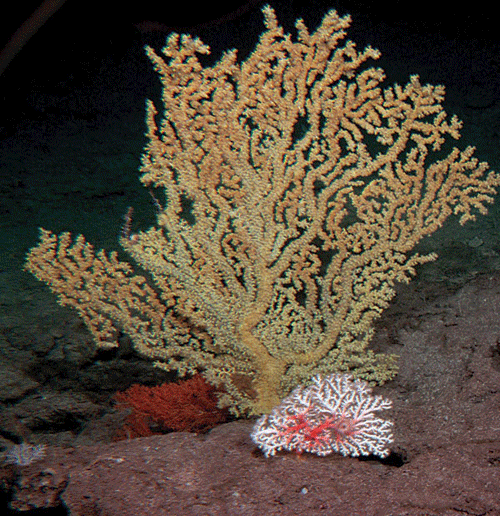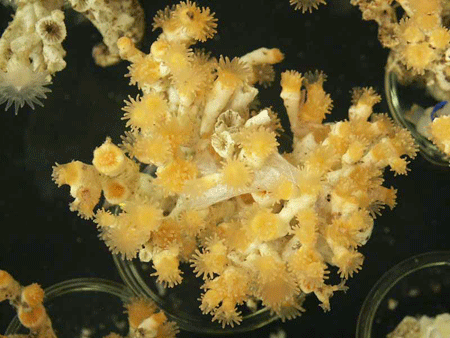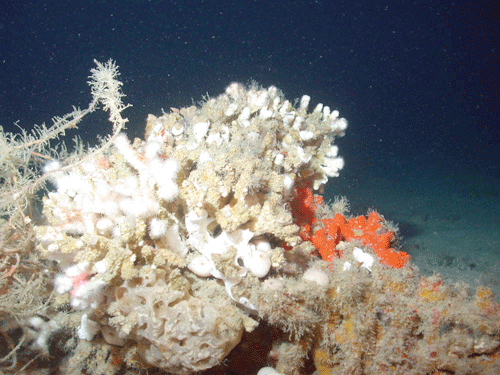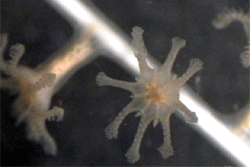Deep Sea Corals
Deep-sea corals are members of the Class of animals called Anthozoa, which among other creatures, includes sea anemones, stony corals, soft corals and sea pens. Deep-sea corals live in the colder deep waters of our continental shelves, submarine canyons, seamounts, mid-ocean ridges and other habitats within the ocean abyss to depths deeper than 6000 m. Where current and substrate conditions are appropriate, these corals can form complex reefs, thickets or groves of high complexity, depending on species. Like to the ancient redwood and sequoia trees, these animals are slow rising and can arrive at hundreds of years to over a millennia in age, they give habitat for a lot of other organisms, and their skeletons give significant historical records of climate change.
The term 'coral' evokes images of shallow sunlit reefs with a wide variety of connected organisms, with a profusion of colorful fishes. Most people are conscious of the role that coral reefs play in behind the local economies of tourist destinations like the Florida Keys and the Hawaiian Islands.
Two Important Deep-water Corals
Two of the more important deep-sea coral species are Lophelia pertusa and Oculina varicosa. These species form wide deep-water communities that attract commercially significant species of fishes, making them vulnerable to unhelpful bottom trawling practices. Increased sedimentation places extra stress on corals.

Oil and gas exploration structures and activities, mainly in the North Sea and adjacent areas, also injure Lophelia communities. Subsequent oil and gas production activities may also introduce harmful substances into these areas.
Lophelia pertusa Distribution

Lophelia pertusa is the most general aggregate-forming deep-water coral. Classically, it is establish at depths between 200 and 1,000 m in the northeast Atlantic, the Mediterranean Sea, along the mid-Atlantic Ridge, the West African and Brazilian coasts, and the length of the eastern shores of North America (e.g., Nova Scotia, Blake Plateau, Florida Straits, Gulf of Mexico) as well as in parts of the Indian and Pacific Oceans. Like tropical coral reefs, Lophelia communities carry diverse marine life, such as sponges, polychaete worms, mollusks, crustaceans, brittle stars, starfish, sea urchins, bryozoans, sea spiders, fishes, and a lot of other vertebrate and invertebrate species.Lophelia has been found most often on the northern European continental shelves between 200 and 1000 m, where temperatures choice from 4° to 12°C, but it has also been establish at depths greater than 2,000 m.
Oculina varicosa Distribution

Oculina varicosa is a branching ivory coral that shape huge but slow-growing, bushy thickets on pinnacles up to 30 m in height. The Oculina Banks, so named since they consist typically of Oculina varicosa, live in 50 to 100 m of water along the continental shelf edge about 26 to 50 km off of Florida's central east coast.
Like the Lophelia thickets, the Oculina Banks host an extensive array of macroinvertebrates and fishes. They also are important spawning grounds for commercially important species of food fishes including gag, scamp, red grouper, speckled hind, black sea bass, red porgy, rock shrimp, and the calico scallop
Ecology of Deep-Sea Coral
Like ancient forests, corals give habitat for a variety of other organisms. Unlike the terrestrial forests, however, little is known about their sharing, ecological role, and conservation status. In fact, recent evidence suggests that fishing has had considerable impacts on these communities in both the North Atlantic and Pacific Oceans. This mutual with their slow growth rate and potential role as habitat for a number of commercially and ecologically important species could make long lasting effects on deep-sea communities. We must recognize the distribution, fundamental life history, reproduction and ecological role of these organisms in order to manage and preserve these forests of the deep.
Coral Systematic
 Imagine gathering a net full of fish and not being able to name them by species. How would it be probable to map their distribution, appreciate their ecological role, or understand if they are common or rare? One of the fundamental problems in working with deep-sea corals is identifying who all of the species are and how they are dispersed. While some species are quite common across ocean basins, finding new species (or sub-species) and range extensions is not uncommon. There is much to learn about the how the variety of coral species are distributed in the deep sea waters of the world.
Imagine gathering a net full of fish and not being able to name them by species. How would it be probable to map their distribution, appreciate their ecological role, or understand if they are common or rare? One of the fundamental problems in working with deep-sea corals is identifying who all of the species are and how they are dispersed. While some species are quite common across ocean basins, finding new species (or sub-species) and range extensions is not uncommon. There is much to learn about the how the variety of coral species are distributed in the deep sea waters of the world.
 Deep Sea Crabs
Deep Sea Crabs